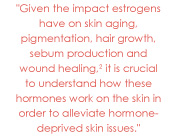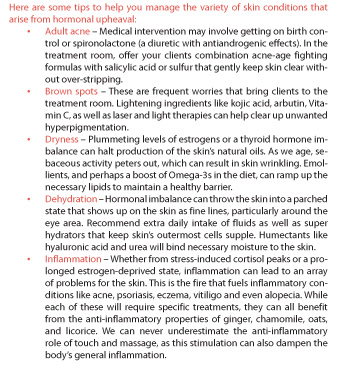Did you ever get a scrape when you were young and have someone say, “Oh it is just skin”? Just skin. As a skin care professional, you know better, but many people continue to devalue the skin as simply an outer covering that keeps the good things in and the bad things out. Indeed, the skin makes for an outstanding barrier, but that understanding is only skin deep. As the body’s largest organ, the skin possesses incredible abilities.
It fights infection, regulates temperature, shields our DNA from solar damage, distinguishes between the tickle of a feather and the abrasiveness of a scrub, and, we have recently discovered, manufactures an array of multi-functional molecules once thought to originate in other tissues. Perhaps this recent discovery will help shift our perspective of the skin from an undervalued protective covering to a dynamic organ that only interfaces with the external world, the internal world, and acts with an independent intelligence that rivals the nervous system. But it takes time to adjust to a new way of thinking.
Over the course of history, there have been a number of accepted truths that were later debunked. Even after science steps in to correct these errors, some people hold on to the old ideas, spurred on by bad information in the media or by a lack of exposure to the new findings.
Some misinformation that seems to circulate includes:
- Hair and fingernails that keep growing after death.
- Different parts of your tongue detect different tastes.
- You only have five senses.
- You only use 10 percent of your brain.
- Deoxygenated blood is blue.
- Most body heat is lost through your head.
- Cracking your knuckles gives you arthritis.

 The world of skin care is not exempt from misleading information. It has been said that tanning booths are safe if they do not use ultraviolet B rays. Other misinformation includes that the higher the SPF, the better the protection; washing oily skin squeaky clean will prevent breakouts; creams can erase wrinkles; and that you do not need to wear sunscreen on a cloudy day. Skin therapists worldwide crusade to educate their clients and friends about these misconceptions – yet they still exist.
The world of skin care is not exempt from misleading information. It has been said that tanning booths are safe if they do not use ultraviolet B rays. Other misinformation includes that the higher the SPF, the better the protection; washing oily skin squeaky clean will prevent breakouts; creams can erase wrinkles; and that you do not need to wear sunscreen on a cloudy day. Skin therapists worldwide crusade to educate their clients and friends about these misconceptions – yet they still exist.
Over the past decade, science has discovered that the skin acts as a hormonal entity. This insight will undoubtedly impact future medical approaches in diagnosing and treating skin conditions. This new information also impacts the professional skin industry. New products emerging with ingredients that maintain hormonal balance on the skin and new technologies are being designed to dampen the symptoms of imbalance.
How did this paradigm shift occur? It starts with our understanding of the endocrine system. Most of us have been taught that the endocrine system consists of special glands located throughout the body that secrete, or pump out, various chemicals known as hormones. We have known for decades how hormones impact the skin, the hair, the brain, or any target organ. For example, we know that sebaceous glands, the dermal manufacturers of sebum, are affected by the male hormones known as androgens, which travel from distant glands like the gonads or adrenals to stimulate oil production. When we think of hormones, we are typically reminded of the teenage years, a period often associated with “raging” hormones. While true, the story is actually much more complex.
Today, we consider the endocrine system a community of organs whose cells emit, receive, and coordinate signals from other organs as well as from themselves.1 The skin also has the capacity to do this. The modern view of the skin is that it receives hormonal signals from other glands, and it produces hormones and enzymes – making it a true endocrine organ. Just as the ovaries can release hormones into the body through the bloodstream, the skin can also produce hormones that are released through blood circulation.1 In fact, the ovaries are not the only ones responsible for producing estrogen. Of course they are the main source of circulating estrogens, but this is only true in non-pregnant, pre-menopausal women.1, 4 We know female menopause reflects an end to the production of sex hormones by the ovaries, but that does not mean a woman’s body no longer produces these hormones. According to research, after a woman has reached menopause, the majority of the sex steroid hormones found in her circulation are actually produced by other organs like the skin.1 Given the impact estrogens have on skin aging, pigmentation, hair growth, sebum production and wound healing,2 it is crucial to understand how these hormones work on the skin in order to alleviate hormone-deprived skin issues.
How Do Hormones Function?
Estrogens and other hormones exert their effects on the body through several methods. Intracrine function is actually the way in which post-menopausal estrogen works – the cells of the tissues, like skin, produce their own necessary hormones for the cells to function. Clearly, sex hormones have bigger roles than simply bringing on puberty. Another important hormone that is produced in the skin is the potent androgen 5α-dihydrotestosterone (DHT). You may recognize this as the culprit responsible for oily skin breakouts. That is true, and the skin that is mostly responsible for producing this powerful hormone. Perhaps in the future, we will see a therapy that balances local skin hormones to clear up acne, without disrupting the delicate hormonal balance of the body.
Along with the sex hormones discussed, the skin as an endocrine organ produces a rich variety of other hormones for its own use, including thyroid hormones, stress hormones like cortisol, and curiously, brain-related chemical messengers (neurotransmitters) like melatonin and serotonin.3 Finally, the skin gallantly manufactures hormones for the rest of the body, the prime example being vitamin D.3 Vitamin D is not only an essential dietary vitamin, but is also a necessary hormone that impacts our overall health. The skin’s complexity should not be much of a surprise given that it is a powerful interface between the mind, the body and our external world. So let us start giving the skin more credit!

Balancing Act
Just as skin professionals teach their clients how to properly cleanse their skin and how to protect it from sun damage, so too can they educate their clients about the vast complexity of human skin. When you prepare a skin treatment or recommend products to your clients, keep in mind that their skin may be going through hormonal changes, which not be limited to life events such as puberty, pregnancy and menopause. While these are periods of particular hormonal upheaval, the skin can undergo hormonal changes on a daily basis and on a monthly basis with female clients. With age, these hormonal fluctuations become more evident. Hormonal fluctuations are reflected on the skin as papules, dehydration, stickier sebum, dryness, loss of elasticity, wrinkle development, increased inflammation, or a combination of these.
One of the greatest challenges for skin care professionals is dealing with the aftermath of hormonal fluctuation. These skin issues are difficult to prevent and will often recur on the same client, so it is important to manage expectations and control each situation as it arises. There are tools at your disposal to help correct some of the effects of hormonal imbalance on the skin.
Due to the persistent nature of these conditions, client compliance with the recommended products and skin care regimen is critical for improved outcome. We must all learn to live with our hormonal fluctuations, but understanding them will help you guide your clients through these changes and provide realistic solutions that minimize unexpected and unwanted skin changes.
 References
References
1 CC Zouboulis, The skin as an endocrine organ. Dermato-Endocrinology (2009) 1:5; 250-252.
2 CC Zouboulis et al., Sexual Hormones in human skin. Horm Metab Res (2007) 39:85-89.
3 MA Zmijewski and AT Slominski, Neuroendocrinology of the skin: An overview and selective analysis. Dermato-Endocrinology (2011) 3:1, 3-10.
4 AT Slominski et al., Steroidogenesis in the skin: Implications for local immune functions. J Steroid Biochem. Mol. Bio. (2013)
 Dr. Claudia Aguirre is a Neuroscientist and skin expert, specializing in the connection between the mind and the body. She received her Bachelor of Science degree from UCLA and earned her doctorate degree from the University of Southern California (USC), where she investigated hormone interactions in the aging brain. She has spent the past several years researching the neuroendocrine system of the skin, and its connection to the nervous system. Dr. Aguirre consults internationally as a professional speaker and writer for the aesthetics and biotech industries. She can be reached at doctorclaudia.com.
Dr. Claudia Aguirre is a Neuroscientist and skin expert, specializing in the connection between the mind and the body. She received her Bachelor of Science degree from UCLA and earned her doctorate degree from the University of Southern California (USC), where she investigated hormone interactions in the aging brain. She has spent the past several years researching the neuroendocrine system of the skin, and its connection to the nervous system. Dr. Aguirre consults internationally as a professional speaker and writer for the aesthetics and biotech industries. She can be reached at doctorclaudia.com.
Want to read more?
Subscribe to one of our monthly plans to continue reading this article.